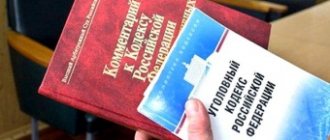Depriving a person of life is classified as a particularly serious crime and is classified as murder. Responsibility for this crime is imposed on the perpetrator in accordance with the provisions of Article 105 of the Criminal Code of the Russian Federation. A special category of crimes within the framework of this article is murder committed out of hooligan motives. Such atrocities are always committed with a pronounced degree of cynicism and open disrespect for other members of society.
Download for viewing and printing:
Article 105. Murder of the Criminal Code of the Russian Federation
Special signs
Let's start with the basics. The commission of any murder always implies the wrongfulness of the actions of the accused. This is a very important aspect that is always taken into account by the court. The fact is that depriving another person of life may well fit within the legal framework:
- execution of a death sentence;
- murders committed during hostilities and in the performance of official duties;
- necessary self-defense, which caused the death of the attacker.
According to current legislation, if the above acts are committed lawfully, they cannot be considered murder, and therefore are not subject to criminal punishment and prosecution.
Against this background, murders for hooligan motives look not only unlawful, but also immoral. In legal practice, they are often called “motiveless,” although this is not an entirely true statement. This qualification is explained by the fact that the accused usually lacks compelling motives for taking the life of another person.
We are not talking about personal enmity, material gain or caution here. The reason may be the slightest nuance, which will seem like a good reason for the killer. In addition, such crimes are often committed while intoxicated and contrast the actions of the accused with the moral and ethical standards of behavior accepted in society.
For example, a tipsy passerby asked a stranger for a cigarette. The victim refused, explaining the refusal by the fact that he was a non-smoker. The accused felt insulted and pulled out a knife and stabbed the victim several times in the heart area, which caused instant death.
This is a vivid example of murder for hooligan reasons: the crime was committed without good reason, the actions of the accused are cynical, the crime was committed in a public place, which is disrespect for society.
Important! For crimes in this category there is a characteristic feature: the actions of the accused must not have a motive. If a crime is committed for material gain or in a mutual fight, even if it happened in a public place, the degree of guilt of the accused will be determined by other points of Article 105 of the Criminal Code of the Russian Federation.
What does hooligan motive for murder mean?
Art. 105 of the Criminal Code of the Russian Federation is entirely devoted to murder. The article presents a huge number of signs of qualifying a crime, among which there are hooligan motives. In Art. 105 of the Criminal Code of the Russian Federation states that murder is the intentional causing of death to another person.
What murder for hooligan motives means is deciphered by a special Resolution of the Plenum, which contains judicial practice of such murders.
In order to accurately determine what the main legal essence of murder for hooligan motives, provided for in paragraph “i” of Part 2 of Art. 105 of the Criminal Code of the Russian Federation, the following circumstances should be taken into account:
- Art. 213 of the Criminal Code of the Russian Federation, which provides for criminal liability for hooliganism, establishes the definition of this concept. According to the article, hooliganism is actions that express the perpetrator’s clear disrespect for public order and members of society. In the case of Art. 105 of the Criminal Code of the Russian Federation, hooliganism reaches such proportions that disrespect is manifested in the potential and real possibility of killing surrounding people.
- Resolution of the Plenum of the Armed Forces of the Russian Federation No. 1 of 1999, which is still in effect in 2022, reflects the exact principles of qualifying murder for hooligan motives. The document says that this kind of murder is not motiveless, it is carried out with the aim of challenging public order and openly demonstrating disrespect and contempt to all members of society.
To correctly qualify an act as murder for hooligan reasons, it is necessary that the initiative in the conflict did not belong to the injured party.
If the murder was the result of unlawful actions of the victim himself, the actions of the guilty person can be assessed from the point of view of Article 108 of the Criminal Code of the Russian Federation as exceeding the limits of necessary defense.
Corpus delicti
Due to the fact that murder for hooligan motives has certain difficulties in qualification, special attention should be paid to the elements of the crime.
All the most important elements must be present in the crime:
- The object of the crime is human life and public order.
- The objective side is a form of causing death to the injured party. All the circumstances of the murder matter: its time, place, use of weapons. A cause-and-effect relationship between the hooligan's actions and the death of the person targeted by the hooligan actions must be proven.
- The subject in this case is a sane person over the age of 14 years. Such a low age limit for prosecution is due to the special gravity of the crime.
- The subjective side is direct or indirect intent, as well as specific socially dangerous motives for the committed action.
Difficulties in qualifying intentional hooligan murder
The Plenum says that in order to correctly qualify this type of crime, special attention must be paid to the analysis of the subjective side.
When, before or after the commission of a murder, hooliganism was present in the criminal’s actions, his behavior will be qualified under Art. 105 and art. 213 of the Criminal Code of the Russian Federation.
In murders for mercenary reasons, hostility or jealousy, the motives of the criminal are always clearly clear, which cannot be said about hooligan murder.
A murder committed for hooligan reasons is always difficult to analyze . The criminal, as a rule, cannot give a definite answer to the question of why he killed the victim. He either doesn't remember or was drunk.
However, in the theory of criminal law it is believed that murder for hooligan reasons always has its own motive.
Criminologists have identified several characteristics that are inherent in individuals who commit murders for hooligan reasons:
- Moral deafness;
- Egocentrism;
- Low educational, intellectual and cultural level;
- Aggression and cynicism;
- Presence of psychological abnormalities.
The criminal should have no motives other than hooliganism when committing a murder.
What is considered attempted murder?
According to legal norms, the term “murder” is used only in cases where the crime ends in the death of the victim.
At the same time, the motives for committing a crime are not taken into account here: carelessness, revenge, hooligan motives. If the victim dies, the perpetrator is charged with murder. If the victim survives, the charge changes its wording to “attempted murder . This implies the fact that the attacker failed to complete his plan due to actions beyond his control.
Let's give an example. A subway passenger who was under the influence of alcohol behaved defiantly, used obscene language and smoked in the carriage. A company of three young men reprimanded him, a fight ensued, during which the tipsy citizen pulled out a pistol and opened fire on his opponents. Two guys died on the spot from their wounds, the third was seriously injured, but doctors arrived in time and were able to save the victim’s life.
Here there is a double murder from hooligan motives and one attempt: the accused wished the death of the victim, but failed to carry out his plan.
Important! An attempt on a person’s life always has direct intent: the criminal initially sets the goal of murder.
What are these hooligan motives?
A crime, when it is disclosed and qualified, is decomposed into its component parts, which include the subjective side. It characterizes how the criminal felt while committing his actions, what thoughts were in his head, what goals he pursued.
Some crimes, and as statistics say, quite a large part of them, are committed due to hooligan motives. This means that the criminal did not set any serious goals for himself, and he had no reason to commit an illegal act. He did not want to take possession of other people's property, did not want to take life. Those. The criminal had no rational motives. He directed his actions against public order.
Resolution of the Plenum of the Supreme Court of the Russian Federation of November 15, 2007
1. In accordance with the law, only such gross violation of public order, expressing clear disrespect for society, which is committed with the use of weapons or objects used as weapons, or for political, ideological, racial, national or religious reasons, can be recognized as criminal hooliganism. hatred or enmity or based on hatred or enmity towards any social group.
We invite you to familiarize yourself with: Agreement on the transfer of goods for a fee
Legal assistance: why it is important
Independent defense from criminal prosecution in the absence of serious knowledge in the field of law is fraught with negative consequences. Taking this into account, in the event of criminal prosecution, you should take care of legal defense as soon as possible. This will allow:
- prevent illegal actions on the part of law enforcement officials and other persons during the investigation;
- objectively evaluate the evidence, including the witness base;
- call witnesses;
- challenge unlawful actions at the right time;
- require certain investigative actions to be taken;
- draw up the necessary social and psychological portrait of the suspect.
All of the above points will allow a competent lawyer to turn the case in favor of his client, prevent a biased court verdict, and reduce the possible punishment by reclassifying the crime.
For all questions related to both the considered and other crimes, you can always call 8 (495) 505-24-50. By scheduling a consultation with lawyer E.M. Murzakova, you can get clear and complete answers to any questions you may have, as well as enlist the support of an experienced specialist in criminal law.
Return to Criminal Cases section
Hooliganism as a special case of hooligan motives
If a person commits actions that are expressed in a gross violation of public order, then his hooligan motives here are transformed into a separate crime described in Art. 213 of the Criminal Code of the Russian Federation. The hooligan has no intention of causing harm to health or life, or destroying or damaging property. He simply expresses his dissatisfaction and disrespect for the people around him. In this case, there may be collusion or resistance to the police.
The classification of the crime is an important point. The type of punishment depends on this. If wording about hooligan motives arises in the case, the accused will face a more severe punishment. Lawyer Ekaterina Mikhailovna Murzakova will help you challenge your qualifications. Her experience in criminal representation helps to find the right arguments in favor of the defense and convey them to the person handling the case or to the judge.
Grounds for refusal to initiate a case
The criminal procedure law includes a comprehensive list of grounds under which a criminal case is not initiated, and if it has already been initiated, then it is subject to termination. When considering crimes whose qualifying feature is hooligan motives (including murder, beatings), it should be borne in mind that the suspect or accused will not be charged with this qualifying feature if during the preliminary investigation or later it turns out that:
1. The initiator of the quarrel was the victim.
2. The reason for the crime was the unlawful behavior of the victim.
3. There was an adversarial relationship between the offender and the victim.
In all of the listed cases, the culprit will not have these motives, that is, when he is brought to justice, this aggravating feature will not be part of the crime.
The corpus delicti according to paragraph “I” of Part 2 of Art. 105 of the Criminal Code of the Russian Federation
Like all other crimes, acts provided for in paragraph “i” of Part 2 of Art. 105 of the Criminal Code of the Russian Federation, have a composition characterized by four main elements:
Subject is a person who can be held accountable. This is any person who has reached the age of 14 years (Part 2 of Article 20 of the Criminal Code of the Russian Federation) and has not been declared insane by the court.- Subjective side . It represents the mental relationship of a person with the actions performed. As in all compositions of Art. 105 of the Criminal Code of the Russian Federation, the subjective side includes guilt in the form of intent (both direct and indirect). However, for paragraph “and” part 2 of this article, motive and motivation are also important.
- The object is what the crime was committed against. The object in this case will be human life.
- The objective side is the form in which illegal behavior is externally manifested. In relation to this type of crime (as in all other elements of Article 105 of the Criminal Code of the Russian Federation), the objective side is expressed in the form of actions that resulted in the death of the victim.
How to prove beatings
So, you or your loved ones were attacked. What to do? Step-by-step detailed instructions for you. Initial stage The injured person is still in a state of shock from the physical and moral suffering suffered. He is confused and confused. But be that as it may, it is “hot on the heels” that the most important materials and evidence are collected.
began to demand my phone to call my mother or that I would call her myself (it was 2 a.m.), he himself was pretty drunk. I refused his requests, after which several obscene expressions were uttered at me and several headbutts in the face, after which he left. Within a few minutes he returned and the same thing happened again, because... I couldn’t quickly leave for the entrance because I was walking on crutches (I’m disabled), hitting and insulting him, he threw a can of beer in my face.
considered at the court hearing dated March 4, 2011 the cassation appeals of the convicted Grunin D.O. and lawyer Amerkhanov F.M. on the verdict of the Kirovsky District Court of Kazan, Republic of Tatarstan dated January 28, 2011, by which Grunin D.O.
under paragraph “a” of Part 2 of Article 116 of the Criminal Code of the Russian Federation to correctional labor for a period of 1 year with the withholding of 10% of earnings to the state income; under Part 2 of Article 162 of the Criminal Code of the Russian Federation with the application of Part 6.1 of Article 88 of the Criminal Code of the Russian Federation to imprisonment for 3 years. By virtue of Part 3 of Article 69 of the Criminal Code of the Russian Federation, for the totality of crimes, a sentence of imprisonment for 3 years and 3 months was finally imposed.
Based on Article 73 of the Criminal Code of the Russian Federation, the sentence was imposed conditionally with a probationary period of 4 years with the imposition of duties: without notifying a specialized government body, do not change your permanent place of residence; appear at registration; officially find employment or study in educational institutions of secondary specialized or higher education, and prove correction by their behavior. Having heard the report of judge Valeev F.R.
The problem of qualifying murders committed from hooligan motives
Abaev David Georgievich,
Master's student, Faculty of Law, North Ossetian State University. K. L. Khetagurova.
The article examines the problematic aspects of qualifying murders committed from hooligan motives. The author analyzes the objective and subjective side of the crime.
Keywords:
murder, a sign of hooligan motives, hooliganism, qualification of hooligan motives, hooligan motive.
Murder occupies a special place among crimes against the person. This is explained not only by the maximum severity of sanctions for qualified and especially qualified murders for Russian criminal law, but also by the fundamental nature of the right to life, its primacy in the hierarchy of natural human rights.
The criminal legislation of the Russian Federation recognizes as murder the unlawful intentional deprivation of the life of another person by a perpetrator.
One of the qualifying signs established by criminal law is the sign of hooligan motives (clause “and” part 2 of article 105 of the Criminal Code of the Russian Federation). The very concept of “hooliganism”, as such in Russian legislation throughout the history of its existence, has had a collective character and basically reflects only the social property of actions containing independent elements of crimes.
Thanks to the Resolution of the Plenum of the Supreme Court of the Russian Federation No. 45 of November 15, 2007 “On judicial practice in criminal cases of hooliganism and other crimes committed with hooligan motives,” the group of “crimes committed with hooligan motives” was introduced into official legal circulation for the first time. The selection of this group was objectively necessary.
Hooliganism as a social phenomenon is dangerous for society. This is determined, firstly, by the fairly wide prevalence of this type of crime, as well as the non-personal nature of the corresponding attacks, their direction against society as a whole, the unpredictability of the actions of the hooligan, the association with more serious acts, and also the fact that in most cases hooliganism is committed in a public place .
The social danger of crimes committed out of hooligan motives is also expressed in its association with the use of weapons or motivated by political, racial, national or religious hatred or enmity, or motivated by hatred or enmity towards any social group.
In law enforcement practice, the qualification of murder for hooligan motives is very contradictory. The guilty person, by committing this crime, expresses disrespect for society and violates the established public order. The difficulty lies in establishing criteria that determine the essence of a violation of public order and clear disrespect for society.
The concept of “hooligan motives” appeared in judicial practice following the Criminal Code of the RSFSR of 1922, which for the first time established criminal liability for hooliganism. Until that moment, hooliganism was known in Russia as a negative social phenomenon, but such a crime was absent in criminal legislation. This was explained by the difficulty of clearly defining the objective signs of this crime.
The fears were soon justified. Article 176 of the 1922 Criminal Code of the RSFSR characterized hooliganism as “mischievous, aimless actions involving a clear display of disrespect for individual citizens or society as a whole.” This article was posted under the heading “other attacks on the person and her dignity” between insult, slander and false denunciation. Subsequently, its wording and location in the Criminal Code changed, but the actions constituting this crime were never specified.
The term “hooligan motives” appeared in judicial practice somewhat earlier than in the law. Article 142 of the Criminal Code of the RSFSR of 1922 stated that murder was considered qualified by motive, provided it was committed out of self-interest, jealousy and “other base motives.” This wording was retained in paragraph “a” of Part 1 of Art. 136 of the Criminal Code of the RSFSR of 1926 until January 1, 1961. The Law did not provide an exhaustive list of base motives, but on March 16, 1925, the Plenum of the Supreme Court of the RSFSR clarified that a type of murder from base motives should be considered murder from hooligan motives. Hooliganism itself is recognized as a socially dangerous phenomenon, as a result of which murder for hooligan motives, if such a motive is established by the court, should be qualified as murder under aggravating circumstances [1, pp. 7-11].
With the adoption of the Criminal Code of 1960, there was no longer any doubt that hooligan motives significantly increased the danger of crimes against life and health. But, as before, the content of the concept of “hooligan motives” was not specifically disclosed, either in the law or in the Resolutions of the Plenum of the Supreme Court.
The practical use of characteristics of the objective side of hooliganism was quite difficult. Defining public order as a system of relations established in society that ensures public peace and the possibility of normal exercise by citizens and organizations of their rights and responsibilities, it is difficult to imagine a crime that would not violate it.
After the introduction and subsequent strengthening of administrative liability for petty hooliganism, criminal liability began to be brought mainly in cases where such crimes were accompanied by violence against the individual.
When in practice the question arose regarding the distinction between hooliganism and crimes against the person, hooligan motives were used as the basis for the delimitation. The official interpretation of this concept was in addition to paragraph “b” of Art. 102 of the Criminal Code of the RSFR of 1960, where, as noted, for the first time responsibility for murder for hooligan motives was directly established [3].
The Resolution of the Plenum of the Supreme Court of the Russian Federation No. 45 of November 15, 2007 “On judicial practice in criminal cases of hooliganism and other crimes committed with hooligan motives” explains the concept of hooliganism, as well as the issues of qualifying a crime with hooligan motives [4].
A murder committed out of hooligan motives is a murder committed on the basis of obvious disrespect for society and generally accepted moral norms, when the behavior of the perpetrator is an open challenge to public order and is caused by the desire to oppose himself to others, to demonstrate a disdainful attitude towards them.
The definition of this concept, presented in paragraph 12 of the mentioned Resolution, is essential for the qualification of crimes committed with hooligan motives. Criminal acts committed out of hooligan motives should be understood as deliberate actions directed against a person’s person or his property, which were committed without any reason or using an insignificant reason. At the same time, in order to correctly establish these motives in the event that the perpetrator commits violent acts during a quarrel or fight, the court needs to find out who was the initiator and whether the conflict was provoked to be used as a reason to commit illegal actions.
In view of the diversity of the essence of crimes committed by hooligan motives, we should talk about the diversity of features of the objective side of such acts. However, these crimes also have certain common features. Such signs, first of all, include a gross violation of public order, as well as obvious disrespect for society and make it possible to distinguish between crimes committed out of hooligan motives.
When committing these crimes, the actions or inaction of the guilty person are aimed specifically at social relations protected by criminal law, however, in such cases, committing murder will be the main object of the crime.
The main objective sign of crimes against human life and health committed out of hooligan motives is the infliction of direct harm to the health of a specific person (people). The social danger of such crimes is expressed in an attack on one of the most valuable goods of a person - his life and health [5].
Murder from hooligan motives assumes that the murder is committed on the basis of obvious disrespect for society, a gross violation of community rules and moral norms, when the behavior of the perpetrator represents an open challenge to public order and is caused by the desire to oppose himself to others, to show his disdain for them. Most often, this type of crime follows an act of hooliganism, usually using a minor reason as a pretext for murder. It is necessary to establish the intent of the perpetrator, which consists not only of an attack on human life, but also on public order.
The Plenum of the Supreme Court of the Russian Federation adheres to the same position, therefore, in paragraph 12 of the resolution of January 27, 1999, it explained the murder committed out of hooligan motives, indicating that paragraph “and” part 2 of Art. 105 of the Criminal Code of the Russian Federation should qualify murder committed on the basis of obvious disrespect for society and generally accepted moral norms, when the behavior of the perpetrator becomes an open challenge to public order and is caused by the desire to oppose himself to others, to demonstrate a disdainful attitude towards them.
When committing a murder for hooligan motives, the perpetrator does not set himself the goal of protecting himself, but receives satisfaction from the very fact of deliberately taking the life of another person. The objective side of killing their hooligan motives is the unlawful deprivation of the life of another person. Unlike simple murder, murder for hooligan motives can only be committed through active actions, since violent actions can only be committed during a quarrel or fight. In some cases, murder for these reasons is the result of provocative actions on the part of the perpetrator. His actions can take the form of both physical and psychological impact on the victim (fear, mental trauma).
When characterizing the objective side of this crime, we note that the use of violence is a mandatory feature that must be taken into account when qualifying.
When characterizing the subjective side of murder for hooligan reasons, one of the key features should be identified - the motive for a socially dangerous act. The hooligan motive is characterized by a wide variety, but there is no reliable mechanism for recognizing motives when committing hooligan actions. All this creates a sufficient number of difficulties in classifying a crime, and therefore there are frequent cases of mistakes being made in investigative and judicial practice [6].
The motive for hooliganism is complex and includes a number of motivations that are similar in nature. For a legislative definition, it is necessary to select the acts of hooliganism that appear in each specific case and, in addition, the most significant of them.
In judicial practice, there are often cases when the intentional infliction of death on another person is groundlessly classified on the basis of “Committed out of hooligan motives.” To correctly resolve such issues, it is necessary to proceed from the fact that an attack on the identity of the victim, his life the reason for which was the hostile relationship between the accused and the victim, as a general rule cannot be assessed as a hooligan motive and should be considered as a crime aimed at deliberately causing the death of a person .
For example, Spiridonov was convicted of murder for hooligan reasons and with extreme cruelty. As stated in the verdict, Spiridonov, being drunk, met victim A, previously unknown to him, on the street.
During a conversation about purchasing alcoholic beverages, using as a minor pretext the fact that the victim had insulted his wife, Spiridonov began to beat the latter, striking him several times with his hands and feet in various parts of his body. As the victim fell, he hit the garage door and then fell to the ground. Spiridonov began throwing stones at the victim who was lying on the ground, striking him in the head. The victim tried to crawl to the side and covered his head with his hands. However, Spiridonov continued to hit him on the head with stones, causing bodily harm in the form of an open head injury. As a result of injuries incompatible with life, the victim died at the scene.
Spiridonov's actions were qualified by the court under paragraphs. “d”, “i” part 2 of Art. 105 of the Criminal Code of the Russian Federation. The convicted Spiridonov, in his supervisory complaint, raised the question of changing the court decisions taken against him, arguing that he did not commit the murder out of hooligan motives and there was no particular cruelty in his actions. The Presidium of the Supreme Court of the Russian Federation partially satisfied the supervisory appeal of the convicted person.
Spiridonov's guilt in the murder was established with particular cruelty. At the same time, the court decisions were changed, since the court's conclusion that the murder was committed for hooligan reasons is erroneous. According to the meaning of the law, murder for hooligan motives is a murder committed on the basis of obvious disrespect for society and generally accepted moral norms, when the behavior of the perpetrator is an open challenge to public order and is caused by the desire to oppose himself to others, to demonstrate a disdainful attitude towards them.
However, no such data has been established in the case. The court found that the murder of the victim was committed out of hooligan motives, since, in the court's opinion, an insignificant reason was used as a pretext for its commission. Meanwhile, Spiridonov consistently asserted in his testimony that the victim had expressed insulting words about his wife, and he decided to “deal with him.”
These testimony of Spiridonov have not been refuted; moreover, they have been recognized by the court as reliable and are given in the verdict.
Given such data, Spiridonov’s actions, committed in response to an offensive statement about his wife, i.e. based on personal hostility, cannot be considered as committed out of hooligan motives.
Conviction of Spiridonov under paragraph “i” of Part 2 of Art. 105 of the Criminal Code of the Russian Federation was excluded from the verdict [5].
Improving Russian criminal legislation and the professional preparedness of practical workers, including the ability to correctly classify committed acts and impose fair punishments for crimes against life and health committed for hooligan reasons, will help to find the most effective methods of combating crimes in this area .
Literature
1. Borzenkov G. Peculiarities of qualification of murders in competition or a combination of several qualifying characteristics // Criminal law. 2007. No. 5.
2. Borisov S.V. Hooliganism, criminal legal and criminological aspects: dis. ...cand. Legal Nauk M., 2005.
3. Volzhenkin B. Hooliganism // Criminal law. 2007. No. 5. P. 17.
4. On judicial practice in criminal cases of hooliganism and other crimes committed out of hooligan motives: Resolution of the Plenum of the Supreme Court of the Russian Federation dated November 15, 2007 No. 45.
5. Review of judicial practice in criminal cases of the Supreme Court of the Russian Federation for the 2nd quarter of 2006 [Electronic resource]: www.vsrf.ru.
6. Rarog A.I. The subjective side of the qualification of crimes M.: 2001. P.37.
Received by the editor on May 19, 2016.








